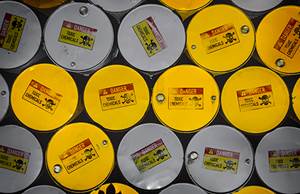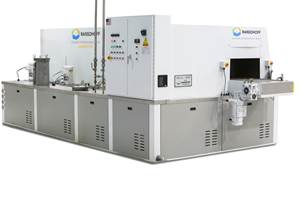Dealing with Failed Cleanliness Limits
Markus Rossler, vice president, Glaeser Inc., offers guidelines for ensuring parts cleaning standards.
Manufacturers of parts and components for various industries face increasing requirements to prove their products are within given limits for particle contamination. Limits might be expressed in particle size, count or gravimetry; stated separately for metallic, nonmetallic and fibrous particles; and may be even more detailed for hardness, conductivity, shape, magnetic properties and more.
Guidelines for inspection methods may vary from industry to industry, but all require suitable extraction and evaluation methods to ensure that results are comparable and that possible improvement actions are traceable.
Typically, once results are repeatedly within the limits, manufacturers can trust that the production processes are adequately set up to achieve the requirements. However, once limits are exceeded, manufacturers might face issues during the production part approval process (PPAP) or requirements by clients for process improvement. While, in many cases, the source or reason for excessive debris is obvious, in others it may be difficult to determine the contamination origins and to select the best method to prevent it.
Here are some guidelines to understand and determine the impact of contamination issues and how to resolve them:
- Ensure inspection results are correct. Unsuitable or unclean inspection equipment may influence the results.
- Experienced and committed lab inspectors are required to ensure the inspections are handled and processed properly.
- This includes the handling and transport of the components from the place of collection in your process. It should eliminate the possibility of cross-contamination.
- Use additional inspections to rule out that the previous result was not exceptional.
- Consider at which stage in the process the components are collected. Typically, components are inspected once they are completely processed and before they are shipped to the next assembly step, either within the manufacturing facilities or at a client’s location.
- Particles may also derive from damaged packaging or cross-contamination from handling.
- If the sources is not obvious, a material analysis of the detected particles can help to indicate the source (for example, components are not individually packaged and the transportation movements are generating particles caused by friction).
- If the products are within the limits before leaving your facilities
but out of limits at incoming inspections at the next process step, then the storage, packaging, handling and transportation has to be observed.

- Before observing the process chain, ensure that components and assembly parts introduced into the process already show the required level of cleanliness. If they do not, the cleaning/washing of the introduced parts needs to be improved. It is essential to observe this — not only for products of your own production but also for any supply part used in an assembly.
- Once it is certain that all parts introduced to an assembly step are clean, you may need to investigate the production/assembly steps. Potential contamination factors are environment, assembly equipment, assembly processes, the worker who performs assembly steps and the logistics.
- Environmental impacts are different, depending on your limits. While some products allow a conventional production, others require the establishment of cleanliness zones, cleanliness rooms or even clean-room operations.
- Assembly facilities need to be clean to avoid cross contamination and recontamination, which requires cleaning schedules and rules.
- Assembly processes may have to be chosen to avoid the generation of particles or, if this cannot be avoided, to allow the immediate removal of the generated particles to avoid carrying the contamination forward.
- Workers need to be trained to understand cleanliness impact, avoid double tasking in different cleanliness levels and use only clean tools, gloves, equipment and surfaces. Reworked parts need to be reintroduced into the process only when in clean condition.
- Logistics cover all aspects from transportation methods, storage, packaging, protection of the parts during breaks and process interruptions, location and handling.
It is essential to break down the processes in steps and inspect components in between those assembly steps to understand which process step requires improvement. If there are several options for improvement, consider implementing only one option at a time so you can measure results in order to understand its impact and avoid unnecessary actions and costs.
Another approach to locate the source of contamination is to perform extended material analysis (for example, by SEM/EDX) and trace where in the process those particles might be introduced. Depending on the type and complexity of the processes and products, this might be the faster option.
The basic key to success is to learn to see your processes “through the goggles of cleanliness.” Training and assessments of your processes by trained experts might help you to understand your situation and speed up improvement processes.
About the Author
Markus Rossler
Glaeser Inc.
Rossler is vice president at Glaeser Inc.
Related Content
Parts Cleaning Sector Shifts Energy Toward Regulatory Changes
With changes in EPA regulations regarding the use of some popular cleaning fluids, cleaning suppliers and end users are readjusting business strategies and/or cleaning processes to meet new requirements.
Read MorePMTS 2023 Product Preview: Parts Cleaning
Learn about some of the latest parts cleaning solutions that will be on display at PMTS 2023.
Read MoreCorrosion Prevention: How to Avoid the Enemy of Metal Parts
This chemical reaction that is a constant, indiscriminate and costly enemy of metal parts is preventable, but intentional measures must be taken and become an essential process within a company’s walls.
Read MoreCool Clean’s Omega 1500 Provides Powerful, Portable Cleaning
PMTS 2023: By selecting the appropriate nozzle and making the necessary propellant pressure and temperature adjustments, the Omega 1500 can clean to a variety of surface cleanliness levels.
Read MoreRead Next
A Tooling Workshop Worth a Visit
Marubeni Citizen-Cincom’s tooling and accessory workshop offers a chance to learn more about ancillary devices that can boost machining efficiency and capability.
Read MoreDo You Have Single Points of Failure?
Plans need to be in place before a catastrophic event occurs.
Read More5 Aspects of PMTS I Appreciate
The three-day edition of the 2025 Precision Machining Technology Show kicks off at the start of April. I’ll be there, and here are some reasons why.
Read More














.jpg;maxWidth=300;quality=90)









